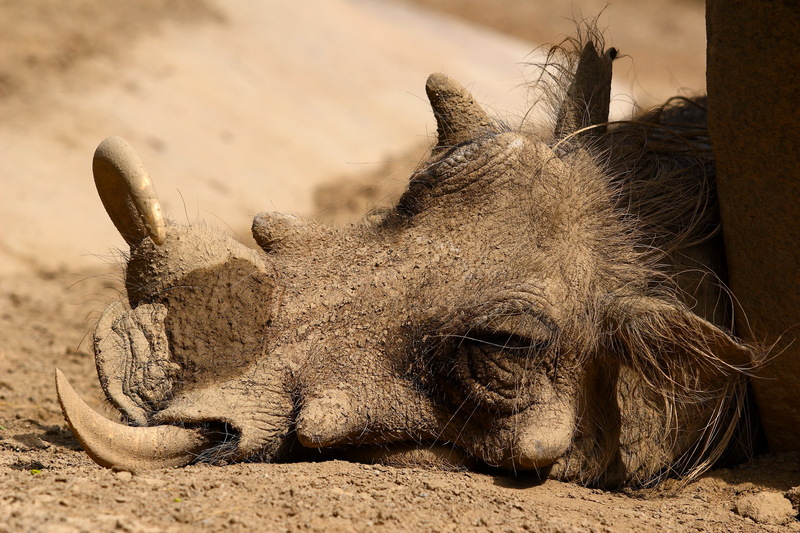|
| 질의: african lion | 결과: 643번째/766 | |
Warthog (Phacochoerus africanus) - Wiki
| 제목: | Warthog (Phacochoerus africanus) - Wiki
| |

| 해상도: 1752x1168
파일크기: 982016 Bytes
촬영일: 2007:09:02 15:18:48
사진기: Canon EOS 30D (Canon)
F number: f/4.5
Exposure: 1/1000 sec
Focal Length: 155/1
등록시간: 2007:09:16 17:57:52
|
Warthog
From Wikipedia, the free encyclopedia
[Photo] A soiled Warthog relaxing during a hot day at San Diego Zoo, California, USA. Date Sep 02, 2007. Author Sanjay ach (http://commons.wikimedia.org/wiki/User:Sanjay_ach)
The Warthog (Phacochoerus africanus) ("African Lens-Pig") is a wild member of the pig family that lives in Africa. The common name comes from the four large wart-like tusks found on the head of the warthog, which serve the purpose of defense when males fight. They are the only widely recognised species in their genus, though some authors divide them into two species. On that classification, P. africanus is the Common (or Northern) Warthog and P. aethiopicus is the Desert Warthog, also known as the Cape Warthog or Somali Warthog.
Description
Warthogs range in size from 0.9 to 1.5 metres (2.9-4.9 feet) in length and 50 to 150 kg (110-330 pounds) in weight. A warthog is identifiable by the two pairs of tusks protruding from the mouth, which are used as weapons against predators. The upper canine teeth can grow to 9 inches (23 cm), and are of a squashed circle shape in cross section, almost rectangular, being about 1¾ in (4.5 cm) deep and 1 in (2.5 cm) wide. The tusk will curve 90 degrees or more from the root, and the tusk will not lie flat on a table, as it curves somewhat backwards as it grows. The tusks are used for digging, for combat with other hogs and in defence against predators -- the lower set can inflict severe wounds.
Warthog ivory is taken from the constantly growing canine teeth. Each warthog has a pair of teeth in each jaw with the lower teeth being far shorter than the upper teeth. Both pairs grow upwards, with the upper teeth being by far the more spectacular in appearance. The lower pair, however, are the more dangerous: the teeth are straight, sharpley pointed, and keep a keen edge by the upper pair rubbing against the lower pair. The tusks, more often the upper set, are worked much in the way of elephant tusks with all designs scaled down. Tusks are carved predominantly for the tourist trade in East and Southern Africa.
Sociality
A grouping of warthogs is called a sounder. Common warthog sounders are usually composed of 3 to 10 animals, although groups as large as 30 have been anecdotally reported. The "core" of the sounder is usually a sow with offspring. A sounder can be composed of multiple males and their respective offspring, and females tend to stay with the family group for several breeding seasons.
Conversely, males tend to live alone or in small groups with individuals that transition in and out of the group, but the males tend to stay within their natal range. Mature males only join female groups when sows are in heat. Males are not territorial, but will fight among themselves for mating opportunities during breeding season, sometimes inflicting significant and serious wounds with tusks.
Ecology
Although warthogs are commonly seen in (and associated with) open grasslands, they will seek shelter and forage in denser vegetation. In fact, warthogs prefer to forage in dense, moist areas when available. The common warthog diet is omnivorous, composed of grasses, roots, berries and other fruits, bark, fungi, eggs, dead animals, and even small mammals, reptiles and birds. The diet is seasonably variable, depending on availability of different food items. Areas with many bulbs, rhizomes and nutritious roots can support large numbers of warthogs. Warthogs are powerful diggers, using both heads and feet. When feeding, they often bend the front legs backwards and move around staying on the knees. Although they can dig their own burrows, they commonly occupy abandoned aardvark burrows. The warthog commonly enters burrows "back-end first", with the head always facing the opening and ready to burst out as needed.
Warthogs are fast runners and quite capable jumpers. They will often run with their tails in the air. Despite poor eyesight, warthogs have a good sense of smell, which they use for locating food, detecting predators and recognizing other animals.
Although capable of fighting, and males will aggressively fight each other during mating season, a primary defense is to flee by means of fast sprinting. The main warthog predators are humans, lions, leopards and hyenas. Cheetahs are also capable of catching small warthogs.
Longevity
Wild warthogs can live up to 15 years, and captive warthogs may live as long as 18 years. The typical gestation period is 5 or 6 months and the litter size is 2 to 8 piglets, although 2 to 4 is more typical. Piglets are weaned at 3 or 4 months of age, reaching sexual maturity at 18 to 24 months. Females may give birth twice per year.
http://en.wikipedia.org/wiki/Warthog
| The text in this page is based on the copyrighted Wikipedia article shown in above URL. It is used under the GNU Free Documentation License. You may redistribute it, verbatim or modified, providing that you comply with the terms of the GFDL. |
|
^o^
동물그림창고 똑똑전화 누리집
^o^
|
|

